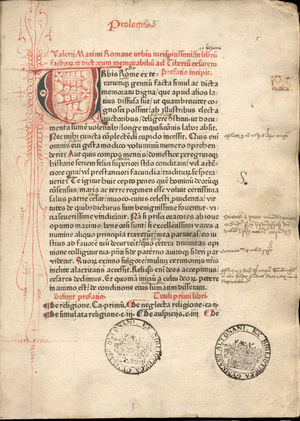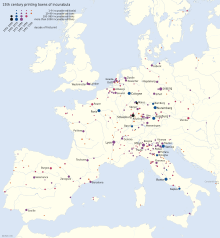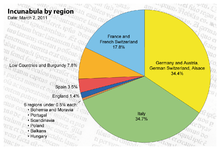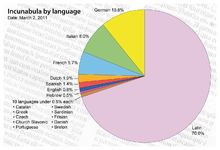Incunable

An incunable, or sometimes incunabulum (plural incunables or incunabula, respectively) is a book, pamphlet, or broadside (such as the Almanach cracoviense ad annum 1474) that was printed—not handwritten—before the year 1501 in Europe. "Incunable" is the anglicised singular form of "incunabula", Latin for "swaddling clothes" or "cradle"[1] which can refer to "the earliest stages or first traces in the development of anything."[2] A former term for "incunable" is "fifteener," referring to the fifteenth century.
The first recorded use of incunabula as a printing term is in a Latin pamphlet by Bernhard von Mallinckrodt, De ortu et progressu artis typographicae ("Of the rise and progress of the typographic art", Cologne, 1639), which includes the phrase prima typographicae incunabula, "the first infancy of printing", a term to which he arbitrarily set an end, 1500, which still stands as a convention.[3] The term came to denote the printed books themselves in the late seventeenth century.
The convenient but arbitrarily chosen end date for identifying a printed book as an incunable does not reflect any notable developments in the printing process, and many books printed for a number of years after 1500 continued to be visually indistinguishable from incunables. "Post-incunable" typically refers to books printed after 1500 up to another arbitrary end date such as 1520 or 1540.
As of 2008, there are between 28,000 and 30,000 distinct incunable editions known to be extant, while the number of surviving copies in Germany alone is estimated at around 125,000.[4][5]
Contents |
[edit] Types
There are two types of incunabula in printing: the Block book printed from a single carved or sculpted wooden block for each page, by the same process as the woodcut in art (these may be called xylographic), and the typographic book, made with individual pieces of cast metal movable type on a printing press. Many authors reserve the term incunabula for the typographic ones only.[6]
The spread of printing to cities both in the north and in Italy ensured that there was great variety in the texts chosen for printing and the styles in which they appeared. Many early typefaces were modelled on local forms of writing or derived from the various European forms of Gothic script, but there were also some derived from documentary scripts (such as most of Caxton's types), and, particularly in Italy, types modelled on handwritten scripts and calligraphy employed by humanists.
Printers congregated in urban centres where there were scholars, ecclesiastics, lawyers, nobles and professionals who formed their major customer base. Standard works in Latin inherited from the medieval tradition formed the bulk of the earliest printing, but as books became cheaper, works in the various vernaculars (or translations of standard works) began to appear.
[edit] Examples and collections
Incunabula include the Gutenberg Bible of 1455, the Peregrinatio in terram sanctam of 1486—printed and illustrated by Erhard Reuwich—both from Mainz, the Nuremberg Chronicle written by Hartmann Schedel and printed by Anton Koberger in 1493, and the Hypnerotomachia Poliphili printed by Aldus Manutius with important illustrations by an unknown artist. Other printers of incunabula were Günther Zainer of Augsburg, Johannes Mentelin and Heinrich Eggestein of Strasbourg, Heinrich Gran of Haguenau and William Caxton of Bruges and London. The first incunable to have woodcut illustrations was Ulrich Boner's Der Edelstein, printed by Albrecht Pfister in Bamberg in 1461.[7]
The British Library's Incunabula Short Title Catalogue now records over 29,000 titles, of which around 27,400 are incunabula editions (not all unique works). Studies of incunabula began in the seventeenth century. Michel Maittaire (1667–1747) and Georg Wolfgang Panzer (1729–1805) arranged printed material chronologically in annals format, and in the first half of the nineteenth century, Ludwig Hain published, Repertorium bibliographicum— a checklist of incunabula arranged alphabetically by author: "Hain numbers" are still a reference point. Hain was expanded in subsequent editions, by Walter A. Copinger and Dietrich Reichling, but it is being superseded by the authoritative modern listing, a German catalogue, the Gesamtkatalog der Wiegendrucke, which has been under way since 1925 and is still being compiled at the Staatsbibliothek zu Berlin. North American holdings were listed by Frederick R. Goff and a worldwide union catalogue is provided by the Incunabula Short Title Catalogue.[8]
The largest collections, with the approximate numbers of incunabula held, include:
[edit] Statistical data
The data in this section were derived from the Incunabula Short-Title Catalogue.[49]
- Printing towns: The number of printing cities stands at 282. These are situated in some 20 countries in terms of present-day boundaries. In descending order of the number of editions printed in each, these are: Italy, Germany, France, Netherlands, Switzerland, Spain, Belgium, England, Austria, Czechoslovakia, Portugal, Poland, Sweden, Denmark, Turkey, Croatia, Montenegro, Balearic Islands, Hungary, and Sicily (see diagram below).
- Languages: The 18 languages that incunabula are printed in, in descending order, are: Latin, German, Italian, French, Dutch, Spanish, English, Hebrew, Catalan, Czech, Greek, Church Slavonic, Portuguese, Swedish, Breton, Danish, Frisian, and Sardinian (see diagram below).
- Illustrations: Only about one edition in ten (i.e. just over 3000) has any illustrations, woodcuts or metalcuts.
- Survival: The 'commonest' incunable is Schedel's Nuremberg Chronicle ("Liber Chronicarum") of 1493, with c 1250 surviving copies (which is also the most heavily illustrated). Very many incunabula are unique, but on average about 18 copies survive of each. This makes the Gutenberg Bible, at 48 or 49 known copies, a rather common (though extremely valuable) edition.
- Total number of volumes: Counting extant incunabula is complicated by the fact that most libraries consider a single volume of a multi-volume work as a separate item, as well as fragments or copies lacking more than half the total leaves. A complete incunable may consist of a slip, or up to ten volumes.
- Formats: In terms of format, the 29,000 odd editions comprise: 2000 broadsides, 9000 folios, 15,000 quartos, 3000 octavos, 18 12mos, 230 16mos, 20 32mos, and 3 64mos.
- Caxton: ISTC at present cites 528 extant copies of books printed by Caxton, which together with 128 fragments makes 656 in total, though many are broadsides or very imperfect (incomplete).
- Dispersal: Apart from migration to mainly North American and Japanese universities, there has been remarkably little movement of incunabula in the last five centuries. None were printed in the Southern Hemisphere, and the latter appears to possess less than 2000 copies – i.e. about 97.75% remain north of the equator. However many incunabula are sold at auction or through the rare book trade every year.
[edit] Post-incunable
The end date for identifying a printed book as an incunable is convenient but was chosen arbitrarily. It does not reflect any notable developments in the printing process around the year 1500. Books printed for a number of years after 1500 continued to look much like incunables, with the notable exception of the small format books printed in italic type introduced by Aldus Manutius in 1501. The term post-incunable is sometimes used to refer to books printed "after 1500 — how long after, the experts have not yet agreed."[50] For books printed on the Continent, the term generally covers 1501–1540, and for books printed in England, 1501–1520.[50]
[edit] See also
[edit] References
- ^ C.T. Lewis and C. Short, A Latin dictionary, Oxford 1879, p. 930. The word incunabula is a neuter plural; the singular incunabulum is never found in Latin and not used in English by most specialists.
- ^ Oxford English Dictionary, 1933, I:188.
- ^ Glomski, J (2001). "Incunabula Typographiae: seventeenth-century views on early printing". The Library 2: 336. doi:10.1093/library/2.4.336.
- ^ British Library: Incunabula Short Title Catalogue gives 29,777 editions as of 8 January 2008, which also includes some prints from the 16th century though (retrieved 11 March 2010).
- ^ According to Bettina Wagner: "Das Second-Life der Wiegendrucke. Die Inkunabelsammlung der Bayerischen Staatsbibliothek", in: Griebel, Rolf; Ceynowa, Klaus (eds.): "Information, Innovation, Inspiration. 450 Jahre Bayerische Staatsbibliothek", K G Saur, München 2008, ISBN 978-3-598-11772-5, pp. 207–224 (207f.) the Incunabula Short Title Catalogue lists 28,107 titles published before 1501.
- ^ Oxford Companion to the Book, ed. M.F. Suarez and H.R. Woudhuysen, OUP, 2010, s.v. 'Incunabulum', p. 815.
- ^ Daniel De Simone (ed), A Heavenly Craft: the Woodcut in Early Printed Books, New York, 2004, p. 48.
- ^ "ISTC". http://www.bl.uk/catalogues/istc/. Retrieved 2009-05-16.
- ^ "Facts and Figures 2009". Bayerische Staatsbibliothek. http://www.bsb-muenchen.de/Facts_and_Figures_2006.280+M57d0acf4f16.0.html. Retrieved 2011-08-20.
- ^ "Incunabula Collections". British Library. http://www.bl.uk/reshelp/findhelprestype/incanab/incunabulacoll/index.html. Retrieved 2012-02-05.
- ^ "Research on Holdings". Österreichische Nationalbibliothek. http://www.onb.ac.at/ev/collections/siawd/siawd_holdings.htm. Retrieved 2012-09-30.
- ^ "Rare Books (Western) - Bodleian Library". Bodleian Library, University of Oxford. http://www.bodleian.ox.ac.uk/bodley/library/special/rarebooks. Retrieved 2012-11-15.
- ^ "Incunabula Cataloguing Project". Cambridge University Library. http://www.lib.cam.ac.uk/deptserv/rarebooks/incunabulaproject.html. Retrieved 2012-03-30.
- ^ "Guida rapida: Informazioni utili" (in Italian). Biblioteca Nazionale di Napoli. http://www.bnnonline.it/guida/infutil.htm. Retrieved 2011-03-07.
- ^ "Zahlen und Fakten" (in German). Staatsbibliothek zu Berlin. http://staatsbibliothek-berlin.de/ueber-uns/fuer-forschung-und-kultur/zahlen-und-fakten.html. Retrieved 2011-03-07.
- ^ Whitesell, David (2006). First supplement to James E. Walsh's Catalogue of the fifteenth-century printed books in the Harvard University Library. Cambridge, Mass.: Houghton Library. p. xiii. ISBN 978-0-674-02145-7. OCLC 71691077.
- ^ "La Biblioteca - Informazioni generali - Patrimonio librario" (in Italian). Biblioteca Nazionale Centrale di Firenze. http://www.bncf.firenze.sbn.it/pagina.php?id=51&rigamenu=Patrimonio. Retrieved 2011-03-07.
- ^ "The Jagiellonian University Library Collection". Biblioteka Jagiellońska. 2009-12-31. http://www.bj.uj.edu.pl/o_bib/bj_w_licz1_en.php. Retrieved 2011-03-07.
- ^ http://www.ub.uu.se/arv/special/einkunab.cfm[dead link]
- ^ "Raccolte - Opere a stampa" (in Italian). Biblioteca comunale dell'Archiginnasio. http://www.archiginnasio.it/html/1raccolte.htm. Retrieved 2011-03-08.
- ^ http://ccfr.bnf.fr/portailccfr/servlet/ViewManager?menu=menu_view&record=rnbcd:INSTITUTION:6929&setCache=rnbcd.INSTITUTION[dead link]
- ^ "Collections" (in French). Bibliothèque Mazarine. http://www.bibliotheque-mazarine.fr/mazcolle.htm. Retrieved 2011-03-08.
- ^ "Les incunables" (in French). Bibliothèque nationale et universitaire de Strasbourg. http://www.bnu.fr/collections/patrimoine/les-incunables. Retrieved 2011-03-08.
- ^ "Collezioni" (in Italian). Biblioteca nazionale centrale di Roma. http://www.bncrm.librari.beniculturali.it/index.php?it/8/collezioni. Retrieved 2011-03-08.
- ^ "Incunaboli" (in Italian). Biblioteca Nazionale Universitaria di Torino. http://www.bnto.librari.beniculturali.it/fondi.php?fondi=1&menun=5. Retrieved 2011-03-08.
- ^ "Incunabula". Biblioteca Nacional de Portugal. http://www.bnportugal.pt/index.php?option=com_content&view=article&id=201&Itemid=160&lang=en. Retrieved 2011-03-15.
- ^ "Il patrimonio bibliografico" (in Italian). Biblioteca Universitaria di Padova. http://www.bibliotecauniversitariapadova.it/il-patrimonio.html. Retrieved 2011-03-08.
- ^ "Les imprimés" (in French). Bibliothèque Sainte-Geneviève. http://www-bsg.univ-paris1.fr/la_reserve/imprimes.htm. Retrieved 2011-03-08.
- ^ "Manuscript and Rare Books". Walters Art Museum. http://art.thewalters.org/viewgallery.aspx?id=1255. Retrieved 2011-03-08.
- ^ "Bibliothèque Municipale de Lyon" (in French). Lectura. http://www.lectura.fr/fr/bibliotheques/index.cfm?code=lyon. Retrieved 2011-03-08.
- ^ "Rare Books". Rare Book & Manuscript Library, University of Illinois. http://www.library.illinois.edu/rbx/RareBooks.htm. Retrieved 2011-08-22.
- ^ "Incunabula: Printing in Europe before 1501". Bridwell Library, Perkins School of Theology, Southern Methodist University. http://www.smu.edu/Bridwell/Collections/SpecialCollectionsandArchives/Overview/Incunabula.aspx. Retrieved 2011-01-04.
- ^ "Glasgow Incunabula Project". University of Glasgow. http://www.gla.ac.uk/services/specialcollections/incunabulaproject/. Retrieved 2012-08-16.
- ^ "Médiathèque Ceccano" (in French). Mairie d'Avignon. http://www.mairie-avignon.fr/fr/pratique/biblio/ceccano.php. Retrieved 2011-03-09.
- ^ Bibliothèque Interuniversitaire de la Sorbonne. Bibliotheque.sorbonne.fr. Retrieved on 2011-02-20.[verification needed]
- ^ U.S. National Library of Medicine, History of Medicine Division. http://nlm.nih.gov/hmd. Retrieved on 2012-02-29.
- ^ "La Bibliothèque Humaniste en quelques chiffres & dates" (in French). Bibliothèque Humaniste de Sélestat. http://www.bh-selestat.fr/rubrique.php?id_rubrique=255. Retrieved 2011-03-09.
- ^ [1]
- ^ http://www.brown.edu/Departments/Medieval_Studies/brown/
- ^ "Incunabula". Harry Ransom Center, The University of Texas at Austin. http://www.hrc.utexas.edu/collections/books/holdings/incunabula/. Retrieved 2011-05-12.
- ^ "Rare Book Collections". University of Chicago Library, Special Collections Research Center. http://www.lib.uchicago.edu/e/spcl/rare.html. Retrieved 2011-08-20.
- ^ Portail de lecture publique. Mediatheques-cus.fr. Retrieved on 2011-02-20.
- ^ La bibliothèque municipale de Strasbourg | Bulletin des Bibliothèques de France. Bbf.enssib.fr. Retrieved on 2011-02-20.
- ^ Bordeaux : Culture – Bibliothèque. Bordeaux.fr. Retrieved on 2011-02-20.
- ^ (French) Patrimoine documentaire / Documentation / Université Montpellier 1 – Université Montpellier 1. Univ-montp1.fr. Retrieved on 2011-02-20.
- ^ [2]
- ^ Supplément au catalogue des incunables et livres du XVIe s. (jusqu'en 1530) de la bibliothèque du grand séminaire de Strasbourg = Supplement to the Catalogue of Incunabulum and Books of the Sixteenth Century (Until 1530) of Strasbourg High Seminary Library. Cat.inist.fr. Retrieved on 2011-02-20.
- ^ First Impressions: Hebrew Printing in the Fifteenth Century, The Library of The Jewish Theological Seminary. Jtsa.edu. Retrieved on 2011-02-20.
- ^ BL.uk, consulted in 2007. The figures are subject to slight change as new copies are reported. Exact figures are given but should be treated as close estimates; they refer to extant editions.
- ^ a b Carter, John; Barker, Nicolas (2004) (PDF). ABC for Book Collectors (8th ed.). New Castle, Del.: Oak Knoll Press and the British Library. p. 172. ISBN 1‒58456‒112‒2. http://www.ilab.org/download.php?object=documentation&id=29. Retrieved 28 May 2010.
[edit] External links
| Wikimedia Commons has media related to: Incunabula |
- Centre for the History of the Book
- British Library worldwide Incunabula Short Title Catalogue
- Gesamtkatalog der Wiegendrucke (GW), partially English version
- History of Incunabula Studies
- UIUC Rare Book & Manuscript Library
- Grand Valley State University Incunabula & 16th Century Printing digital collections



